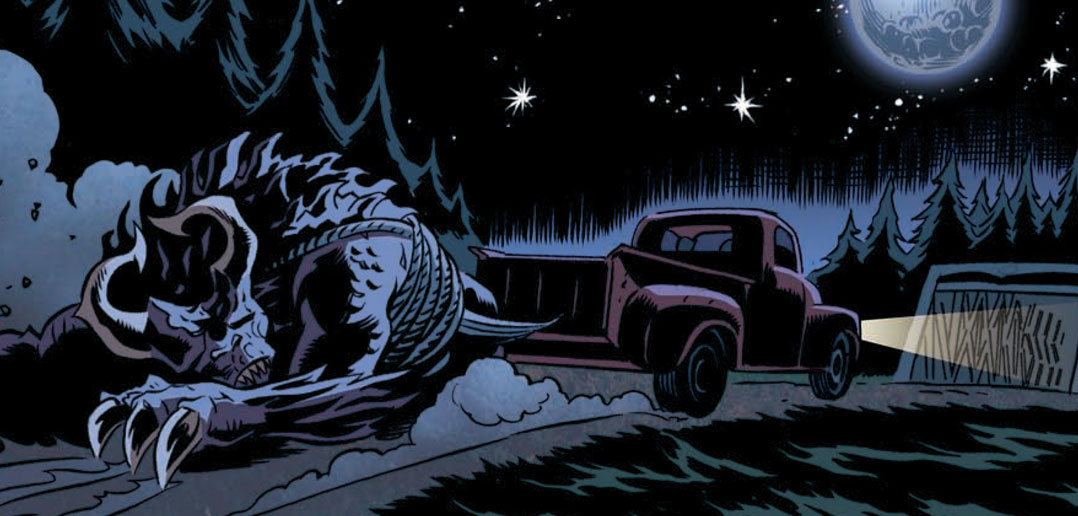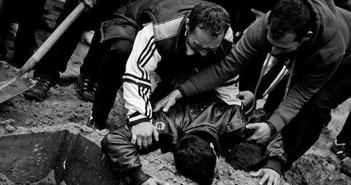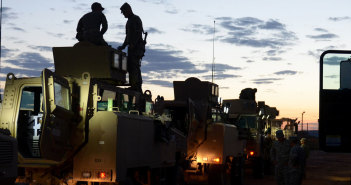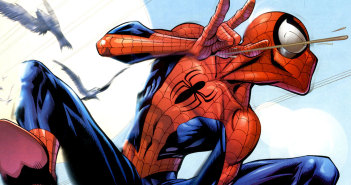There is a special quality captured in Laura Harkcom and Chris Leone’s We Kill Monsters. Yes, the book is quite original: consider it some kind of fusion between the Discovery Channel’s Monster Garage and the two Ghost Busters films. But the series’ true charm lies in its limited cast. There are only three main characters: Jake and Drew Basher and Vanessa, Drew’s one-time fiancé.
These are the three heroes that face down all of the trials and terrors that pollute the rural Kern County. But it wasn’t always like that. Originally, Jake and Drew operated a quiet automotive repair shop called Basher Bros, situated below their Norman Bates-looking home sitting atop a very steep hill. The brothers share an unknown tragic past that is never revealed in the story. I gather their father introduced them to the joys of carburetors and brake systems but died a sudden and tragic death, leaving the boys to raise themselves. Their love for cars binds them together just as much as their mutual loss.
This lonely family dynamic intruded into the elder Drew’s romantic relationship with the feisty barmaid, Vanessa. She gave Drew an unspoken (although impossible) ultimatum: he’d have to choose either her or Jake. He chose Jake, and Jake knows it. He’s plagued by guilt, and Drew and Vanessa in turn know that, pestering them with guilt, too. These are three forlorn people trapped in a lost town in rural America.
And who could forget the monsters that populate this book? There are a lot of them, and they’re all interesting to look at. Artist Brian Churilla embraced his inner whimsy in order to make these creatures special. One looks like the Easter Bunny on LSD, while another tentacle-whipping beast could have been plucked from H.P. Lovecraft’s deliciously bizarre imagination. And those are only two—there are plenty more where they came from.
At the beginning of the story, the creatures appear in Kern County for unknown reasons. They simply wander around, killing any innocent person who stumbles into their path. Eventually, one nasty blue creature chases down Jake and Drew, wounding the former in the process. His arm mutates as a result, becoming an appendage of the creature that cursed him. This is a reoccurring theme throughout the book: in each issue Jake’s arm takes on a new form depending on which creature’s biological matter he feeds on in order to stay alive. Think of it as a gory Happy Meal toy from McDonald’s. Collect them all!
Kern County progressively suffers as a result of the monster attacks, though we rarely see the other residents. It’s interesting to note how sparse Harkcom and Leone keep We Kill Monsters; aside from the three main characters, the only other person to mention is Dennis, Vanessa’s slick and somewhat sleazy boyfriend. An instant rivalry occurs when the Bashers and Dennis meet for the first time, and it carries through the series until its conclusion.
When I originally reviewed the second issue of We Kill Monsters in August 2009 for Comic News, I said the following: “There’s a hint of backwoods claustrophobia, as if the town in the story is all alone, completely cut off from the rest of the world.” I appreciate this much more looking at the entire series at one time. I always recognized that Harkcom, Leone, and Churilla knew what they were doing, but now I can fully see it. I don’t want to spoil the ending even if the series has been out in issue-form for about a year now, for it’s not really necessary. The finale of the book does what it needs to without stepping on the toes of the rest of the series.
I’m leery of categorizing We Kill Monsters. It’s funny, it’s sweet, and it’s very cool to look at. All I can say is I really like this book, more so than when I read all of the issues individually. There are times when the plot suffers obvious holes (especially in between the first and second issue), but they ultimately don’t matter. For a book with “monsters” in the title, it’s a rather human story. Jake and Drew and blue-collar guys doing what they have to in order to get by, and when they hear their call to adventure, they don’t’ hesitate to answer. This is true for Vanessa as well, who I once compared to Tulip from Preacher. I stand by that comparison now more than ever.
But what I love now more than ever is the artwork of Brian Churilla. I never gave it the due it deserved when I read the individual issues. He captures a subtle tone of light-hearted adventure fused with serious interpersonal relationships. He’s a real talent, and his progression from the first to final issue is apparent. There’s a wonderfully Orwellian scene in issue five of Vanessa wandering around a factory with massive computer panels projecting the image of a corporate bureaucrat espousing the virtues of breakfast cereal (I won’t even bother to explain the meaning of this—simply read the book to understand what I am talking about). I was instantly reminded of the famous Super Bowl ad entitled “1984” that promoted the new Apple Macintosh computer (of the day). It is images of great depth perception like this that give We Kill Monsters a special immersive quality.
After a year of keeping up with We Kill Monsters, I can make my final judgment on this book: it’s a winner. It deserves to be placed next to Red 5 Comics’ other titles like the fantastic Neozoic and the enduring Atomic Robo. I have a parting message for Laura Harkcom, Chris Leone, and Brian Churilla and everyone else who contributed to We Kill Monsters: you are all talented, so never give up on your work!
This comic book review originally appeared in the Frontiersman digital magazine. To view the PDF version of the piece’s original publication, please click here.




